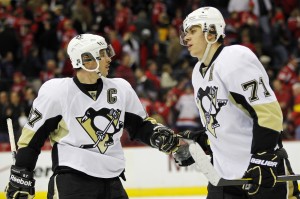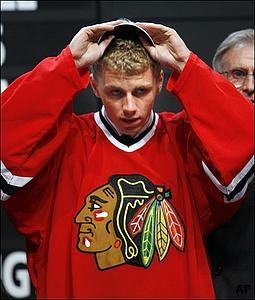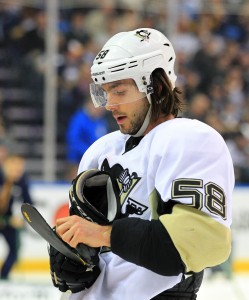Remember a few years ago when the Pittsburgh Penguins were the toast of the NHL? The Pens were coming off back to back Stanley Cup Final appearances that ultimately culminated with the club’s third championship in team history. Furthermore, in Sidney Crosby and Evgeni Malkin, Pittsburgh employed arguably the two greatest players in the world who, between them, had already brought home a Calder, Lester, Hart, Conn Smythe and (2) Art Ross Trophies. And each was just entering the prime of his career; clearly, to say Pittsburgh had a bright future would be an understatement.

But a funny thing happened along the path to becoming the greatest team this side of the mid-’80’s Edmonton Oilers: the Penguins have begun to struggle mightily in the playoffs. Sure, the team still dominates during the regular season while Malkin and Crosby (when healthy) continue to accumulate individual awards but the Penguins have gone 20-21 in the postseason since last sipping champagne from the most famous trophy in all of sports.
Of course, there are plenty of reasons Pittsburgh has come up short in each of the last four seasons. In 2010, they simply ran out of gas after two straight trips to the Finals and ran into a hot goaltender in Montreal’s Jaroslav Halak. In 2011, injuries to Crosby and Malkin kept the Pens from getting past the Lightning in the first round. 2012 was an anomaly, as Pittsburgh (more specifically, Marc-Andre Fleury) imploded against arch-rival Philadelphia in a devastating first round upset. This year, the league’s most potent offense managed only two goals against the Boston Bruins in route to being swept aside in the Conference Final as Claude Julien grossly out-coached Dan Bylsma.
But, you know what? All those reasons for failure are nothing more than excuses. The fact remains that the Penguins have neither lived up to the hype nor evolved into the team many people envisioned. Since that ’09 Cup run, Pittsburgh has experienced two heartbreaking Game 7 setbacks on home ice while being eliminated from the playoffs by four clubs that have each been seeded lower than the Penguins.
And as the Penguins continue to underachieve, another club is taking advantage of the opportunity to rise from the ashes and assert itself as the premiere organization in the NHL:
The Chicago Blackhawks
Much like Pittsburgh, the Blackhawks were able to build a club that should contend for years to come as a result of several years of futility. In fact, immediately after the Pens were able to bring in Malkin (2004) and Crosby (2005) to build their franchise around, Chicago used the draft to land Jonathan Toews (2006) and Patrick Kane (2007). It was only a matter of time before the Hawks followed in the Penguins’ footsteps and established themselves as one of the dominant clubs in the league.

And after doing just that by matching Pittsburgh with a Stanley Cup of their own in 2010, the Blackhawks have spent the last three years asserting themselves as the NHL’s most dominant team. After following up the ’10 championship by squeaking into the playoffs as a result of significant roster shakeups, Chicago still managed to take the President’s Trophy-winning Canucks to the brink, eventually succumbing in an epic seven game series. The Hawks followed that up with a 101 point campaign that ultimately resulted in a postseason loss to a surprising Phoenix Coyotes squad.
But it was the 2013 season that truly cemented the Blackhawks as today’s model NHL franchise. Coming out of the lockout, Chicago went an unprecedented 24 games without a loss in reglulation and rode that momentum all the way to the President’s Trophy. Then, shaking off the typical misfortune that so often accompanies finishing the regular season as the league’s top team, the Hawks went on to capture their second Cup in four years. By defeating the Boston Bruins in one of the most entertaining Finals match-ups in recent history, the Blackhawks became the first team this side of the 2004-’05 lockout to capture a second Stanley Cup title. And, in doing so, Chicago has (at least temporarily) set themselves up to be looked back on as the elite club that many people had once pegged the Pittsburgh Penguins to become.
The Penguins’ Future
While recent Penguin postseason runs have left something to be desired, it’s not as if the club’s core is on the back nine of its time together. Specifically, Ray Shero has invested in building around Sidney Crosby (25) and Evgeni Malkin (26), both of whom are once in a generation players. While there are some question marks surrounding the squad built around the superstar centers, the Penguins (at least in the short-term) are still one of the most skilled teams in the NHL. In fact, according to some experts, Pittsburgh is the early favorite to capture the Stanley Cup next season. Whether or not these predictions are warranted, it’s hard to argue with the talent and potential in the Penguins’ locker room.

And while that locker room will likely house at least a few different players for the start of the 2013-’14 season (let the speculation run rampant with the NHL Draft approaching and Kris Letang reportedly turning down Shero’s latest offer on a contract extension), “The Room” will be home to more familiar faces than many expected. With Coach Dan Bylsma and goaltender Marc-Andre Fleury slated to return, there will be more than one Penguin anxious to prove the organization didn’t make a mistake in retaining its coach and “franchise goaltender”.
Regardless of who fills out the roster or who is behind the bench, it’s time for the Penguins to step up. In being lucky enough to draft both Sid and Geno, the club caught lightning in a bottle and, as a result, needs to capitalize on the opportunity to win multiple Cups. Anything less, fair or not, would ultimately be deemed a failure. And if the current trend continues, when the Sidney Crosby/Evgeni Malkin era eventually ends, history may not look back on these Penguins as anything more than an extraordinarily talented team that typically wilted on the biggest of stages only to watch the Blackhawks blossom and secure their place in NHL lore.